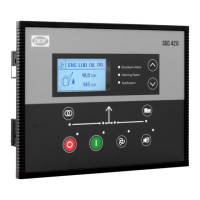Figure 4.2 SGC 421 typical wiring
‐
120
G
+
+ -
+
1 2 3 4 5 6 7 8 9 1610 11 12 13 14 15 21 22 24 25 17 18
1
4
19
2
20
3
31 32 58 59
33 34 35 36 37 38 39 40 41 50 51 52 5354 55 56 5743 4842 45 44 47 46 49
‐
ECU
GOV
G
D+
B+
F1
Outputs
Supply
DC (+)
DC (-)
Output
Output
Output
Output
Output
Output
Output
Analogue inputs
Input
Input
Input
Input
Input
Input
D+
Tacho
E-Gov
BTS
battery
DC (+)
DC (-)
Data + (A)
Data - (B)
RS485
Low
High
CAN
ECU
USB
AC voltage
Mains
N
L1
L2
L3
Digital inputs (configurable)
Input
Input
Input
Input
Input
Input
Input
Input
Input
AC current CT
AC voltage
genset
N
L1
L2
L3
L1 (s1)
L4 (s2)
L1 (s2)
L2 (s1)
L2 (s2)
L3 (s1)
L3 (s2)
L4 (s1)
F4
s2
s1
P2
P1
L1
L2
L3
N
L1
L2
L3
N
F5
MBGB
s2s1
P2P1
s2s1
P2P1
P2P1
s2
s1
Engine
body
Sensor
common
NOTE • Wiring diagrams are examples. Use the application's wiring diagram during installation.
• Genset and mains contactor latching relays should be compiled against 4 kV surge as per IEC-61000-4-5 standard.
• Relay cards used with the controller should be protected against reverse battery voltages.
• Analogue input 2 used for Fuel level sensor can be wired with the reference to Battery Negative, see Specifications,
Analogue resistive sensor inputs.
• Communication ports for CAN ( terminals 58 and 59) and RS-485 (terminals 31 and 32) have built-in 120 Ω termination
resistors.
• If a digital output is connected to a relay, the relay must include freewheeling diodes.
USER MANUAL 4189341227A UK Page 19 of 86

